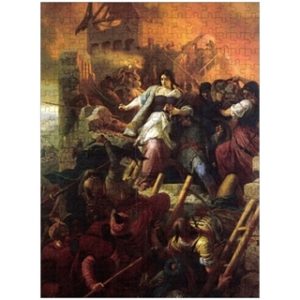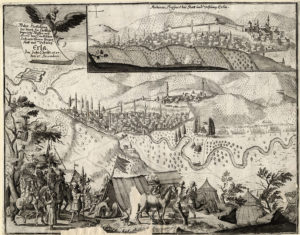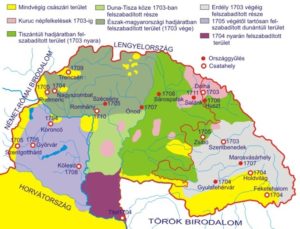Eger

The castle of Eger (Erlau in German) is in northern Hungary. As it is, after much hesitation I have added it to the Ottoman Occupied Lands, because after a heroic period, it was finally taken by the Ottomans. Eger guarded the roads to the mining towns in the west of Upper Hungary and to the east to the great city of Kassa (Kosice, Kaschau). Have a look at the animation video of Pazirik Kft, which shows us the construction of Eger before 1552:
https://www.youtube.com/watch?v=PTqOhKt-Ncc

The town was already an episcopal center in the time of Saint Istvan in 1009. Its stone castle was built after 1248. The famous wine production dates back to the 14th century, but red wine was produced later. During the Ottoman wars, contrary to legend, the warriors drank white wine. (Note that I use the Oriental name order for Hungarian names, where the surname comes first).
Enjoy this trailer: https://www.youtube.com/watch?v=CkA2JoADHds
The famous siege of Eger in 1552
In the autumn of 1552, Captain Dobó István and his 2200 soldiers successfully defended the fortress and northern Hungary from the expanding Ottoman Empire. The Ottoman army was led by Kara Achmed Pasha and consisted of 35-40,000 men from the Rumelian army (and an Anatolian contingent) and the troops of Ahmed Pasha of Buda. The Ottomans had 16 zarbuzans (very large siege cannons), 150 medium and small pieces of artillery, and a fleet of 2,000 camels, which proved very useful in collecting and transporting wood to the site for the construction of temporary siege platforms.
The defenders had 6 large cannons and about a dozen smaller ones, as well as about 300 trench guns with plenty of ammunition. During the siege, Dobó’s officer, Bornemissza Gergely, devised primitive but deadly shells and bombs the size of powder kegs to use against the attackers, as well as a water mill wheel filled with gunpowder which he rolled into the Ottoman ranks. His secret was to make the gunpowder not just explode, but create more fire. He loaded these weapons with oil, sulfur, and flint to shower the enemy with flaming missiles.

The Ottomans had expected an easy victory, but the bravery of the castle’s defenders and Dobó’s inspired leadership resisted and repelled repeated Ottoman attacks. Even after the storage tower containing 24 tonnes of black powder exploded, causing extensive structural damage, the invaders were still unable to find a way into the castle. The defenders lost about a third of their ranks, including those killed or permanently maimed in battle.

There was considerable infighting between the two Ottoman leaders, Pasha Ali and Pasha Ahmed. Ahmed was the senior of the two and contributed twice as many troops to the combined army, but Ali showed more strategic talent and proved his skill with artillery, severely damaging the castle walls with his battery of just four large siege cannons.

During the siege, the Ottoman army ran out of gunpowder and cannonballs (which were carved from marble) at least twice, limiting Ahmed’s use of heavy artillery for a week or more. The end of autumn arrived earlier than usual, with heavy rains and freezing night temperatures. Reduced rice rations and allegations of corruption among officers caused discontent among the Ottoman troops. After 39 days of bloody, brutal, and intense fighting, the Ottoman army withdrew, beaten and humiliated.

Despite the failure at Eger, the Ottomans had no reason to lament the campaign of 1552, for they had taken Veszprém, Temesvár, Szolnok, and Lippa, as well as some twenty-five Hungarian fortresses. Despite the disparity in troop numbers, Eger’s strong walls and the high morale of its defenders enabled the fortress to withstand five major assaults and continuous cannon fire (not counting those stuck in the walls of the fortress, almost 12,000 cannonballs landed inside the fortress before the siege ended).

The women of Eger also took part in the fighting on the walls and their heroism became legendary. (It was all the more humiliating for the Muslims.) The point is that Dobó István and his soldiers successfully defended the fortress and it was the first time the Turks were defeated after the Battle of Mohács in 1526. The famous Hungarian poet Balassi Bálint served here for several years from April 1578. After the victory, Dobó and his officers resigned in protest against King Ferdinand’s refusal to provide material support for the defense.

Photo: Imre Lánczi
The first notable writer to refer to the story was the Hungarian Renaissance poet and musician Tinódi Lantos Sebestyén (c. 1510-1556), whose account may have been partly based on eyewitnesses. The Siege can also be read in English because, in the 19th century, there was a Hungarian writer, Gárdonyi Géza, who wrote his novel “Eclipse of the Crescent Moon”.

Bornemissza Gergely was appointed to take command of the fortress. He was later ambushed, captured, and hanged by the Ottomans. The fortress of Eger defied Ottoman attacks until 1596, when 7,000 defenders, mostly foreign mercenaries, surrendered to the Ottoman forces personally commanded by Sultan Mehmed III. The city remained in Ottoman hands for 91 years. The minaret, built at the end of the 17th century, is a reminder of this period. Among all the buildings of this type, the minaret of Eger is located at the northernmost point of the former Ottoman Empire.

During the Turkish occupation, Eger became the seat of a vilayet, an Ottoman domain comprising several sanjaks. Churches were converted into mosques, the castle was rebuilt and other buildings were constructed, including public baths and minarets. It was the northernmost city in the Ottoman Empire where a minaret could be seen. The Ottoman warriors of Eger Castle gained a formidable reputation in the region.

The liberation of Eger castle in 1687


Hearing of this, Caraffa and Heissler approached the castle with 1,500 Hungarian hussars and 1,000 German cavalry. Petneházy’s hussars lured the castle’s defenders into a trap. The Turks were led into a nearby valley where they were surrounded and attacked. The Begler Bey of Eger, Pasha Oszmán, fell there with his 140 men, and 40 soldiers were taken prisoner. This is how the new pasha, Rusztem, was appointed.


At the beginning of April, Caraffa moved his troops from Kassa (Kosice, Kaschau) towards Eger, which had already been guarded by Hungarian light cavalry units to block the route of any wagons that might be carrying food into the fortress. Lieutenant-Colonel Count Giovanni Battista Doria was appointed to lead the army blockading the fortress. His first troops arrived in June, approaching Eger from the south. Doria’s headquarters were in the village of Maklár and he set up camp on a small hill overlooking the town from the south.







2 January 1705 The castle of Eger falls into the hands of the Kuruc troops
Rákóczi himself wrote the following about Eger in his later memoirs: ‘Eger Castle was an old-fashioned fortress, with old towers on the city side and a very high, two-horned defence on the vineyard side, which the Germans had destroyed before the war. (…) My mediocre guns did not harm the old walls at all, but I learned from the deserters that the shaking caused by the bombs had cracked the water containers and water was beginning to leak out of them.”

From the summer of 1703, Captain Henrik Mohr was in command of Eger Castle, but on 3 October the Imperial Military Council appointed Count Ferdinand von Zinzendorf as its new commander, due to the growing Kuruc threat. He reached his post only by an adventurous route, in a peasant’s guise among the Kuruc troops. The garrison was not very large, about 150 German infantry and 200 hussars.

The 9,000-strong Kuruc army of Bercsényi Miklós appeared under the castle at the end of October, joined by the noble insurgent army of Almássy János, the Vice Comes of Heves County. The Hungarian population of the town immediately surrendered to the besiegers, but the castle held firm. Bercsényi himself did not stay long, as in early November he was ordered to Zólyom to stop the Imperial counterattack that had been launched after Ocskay’s defeat. Almássy’s rebels were not fit to besiege the castle, so they blockaded Eger. On 1 March 1704, however, Rákóczi personally marched from Miskolc to the castle, bringing artillery with him.

He stayed here until mid-April, with a few interruptions, and kept shooting at the walls. However, the artillery action proved to be a waste of effort, with little damage to the walls. As he wrote: ‘I made no progress with the siege of Eger’. Bercsényi Miklós, with his mocking and angry nature, wrote to Rákóczi: “Eger! Eger! It is not good for us to hunt for mice (hunt for mice = egerészni)!” He referred to the whole siege operation as “Your Majesty’s Eger-ing (mice-hunting)”.

The commander of the siege army of Eger was General Count Forgách Simon, who had recently joined the Kuruc troops. He began negotiations with Zinzendorff, and on 16 April the agreement was signed. According to this agreement, the forces of both sides would remain passive for eight months, and if no help arrived to relieve the fortress by 17 December, the defenders would surrender it. The guards and the population inside the castle would then decide whether to return to the Imperials or join the Kuruc. In the former case, they can go to Buda with an armed escort. Rákóczi was then forced to retreat from Eger and headed for the Alföld Plain. It was to be feared that General Siegbert Heister, who had recaptured the Danube region, would also cross the Plain.

In April 1704, the Imperial Military Council received news that the castle had capitulated. They were slow to learn the true facts, but even then there were many inaccuracies. Plans were made to relieve the castle, but they were doomed to failure.
As no relief army reached Eger, Zinzendorff opened the gates on 2 January 1705. “On 2 January 1705 the castle fell into the hands of the Kuruc, and on Friday at noon the soldiers and citizens, the Serbs, marched in fine ranks, in almost military order, with flags flying, drums, horns and 600 carts with family members and belongings, towards Buda.” Wrote an eyewitness. At Kál, however, the soldiers were disarmed, the officers were escorted under heavy guard to Kassa and imprisoned, and the soldiers were forced to swear an oath of allegiance to Rákóczi. Many rich citizens with Imperial loyalty were looted and driven back to the city, but they also had to spend the cold nights in the open air outside the city.

The first commander of the castle was the notary of Ung County, Ráthy Gergely (he had already supervised the fulfillment of the surrender treaty in the castle in the spring of 1704). Later on, he stayed here often and willingly, and Eger became one of the centres of the Kuruc state lacking a capital.
The legacy of Eger Castle
A famous film was made about this siege in Hungary in the 1960s, but I have heard false rumors that a new version is being made in Hollywood. I doubt there will be a new film any time soon. Eger has become an emblem of national defense, a symbol of patriotic heroism, and the superiority of a national army over an unmotivated foreign mercenary force.

Sources: partly from Szibler Gábor
Dear Readers, I can only make this content available through small donations or by selling my books or T-shirts:
Please, feel free to support me with a coffee here:
You can check out my books on Amazon or Draft2Digital, they are available in hardcover, paperback, or ebook:
https://www.amazon.com/dp/198020490X or at https://books2read.com/b/boYd81

My work can also be followed and supported on Patreon: Become a Patron!http://Become a Patron!

[wpedon id=”9140″]

https://hungarianottomanwars.myspreadshop.com/all

Looking at the pictures taken in 2020-2021, there are still many things to complete in Eger Castle. Here are more photos of Eger castle, the first two sets were taken by Lánczi Imre and Ádám Attila in 2020-2021:





































